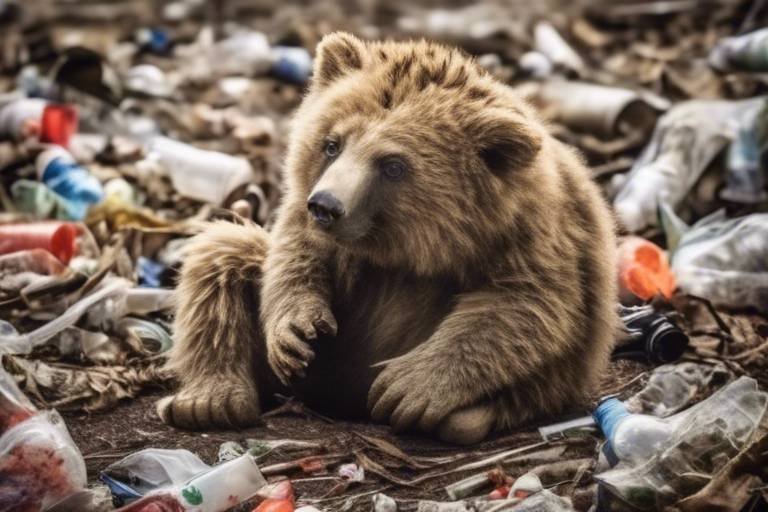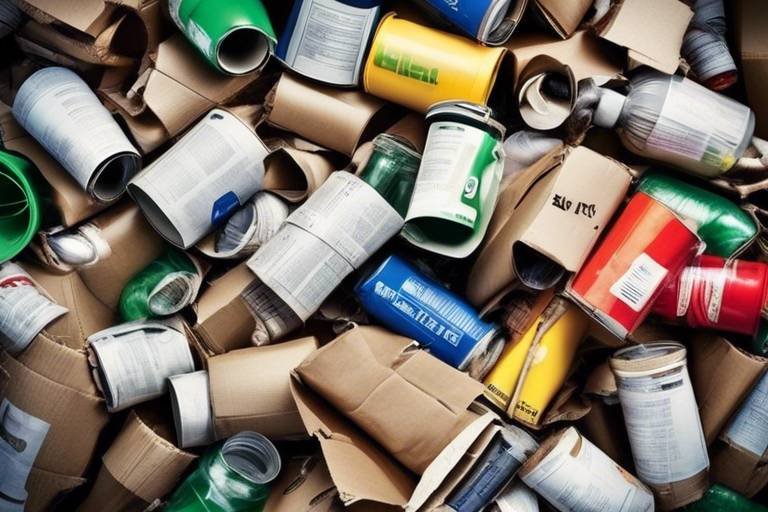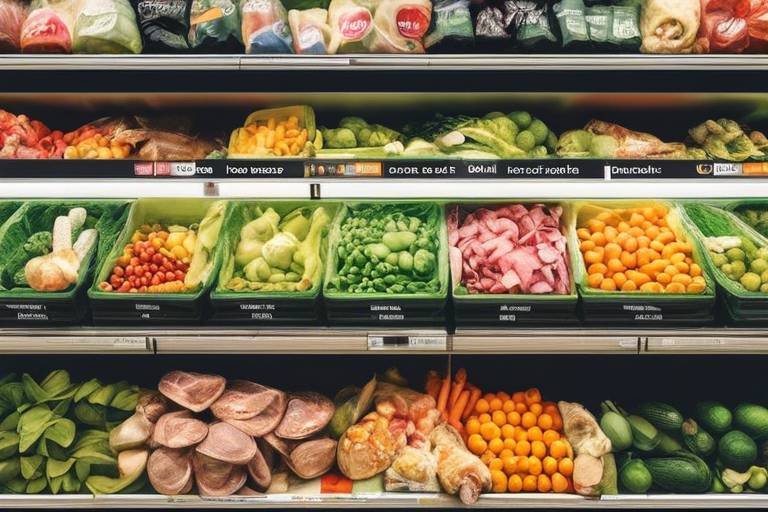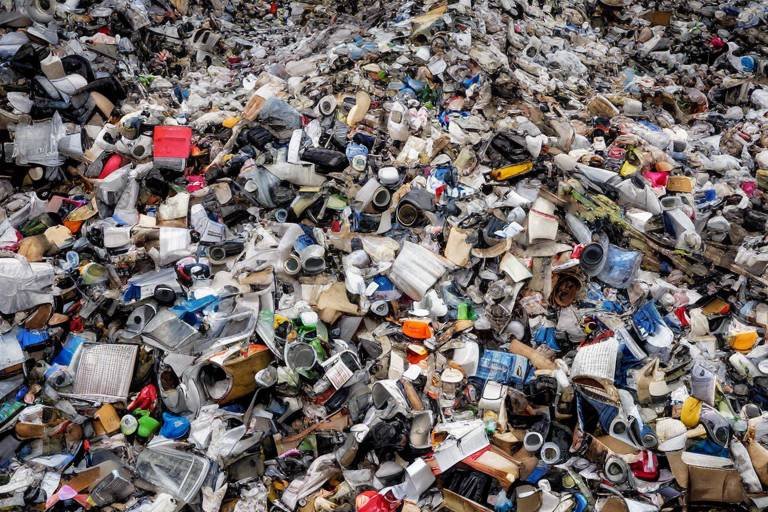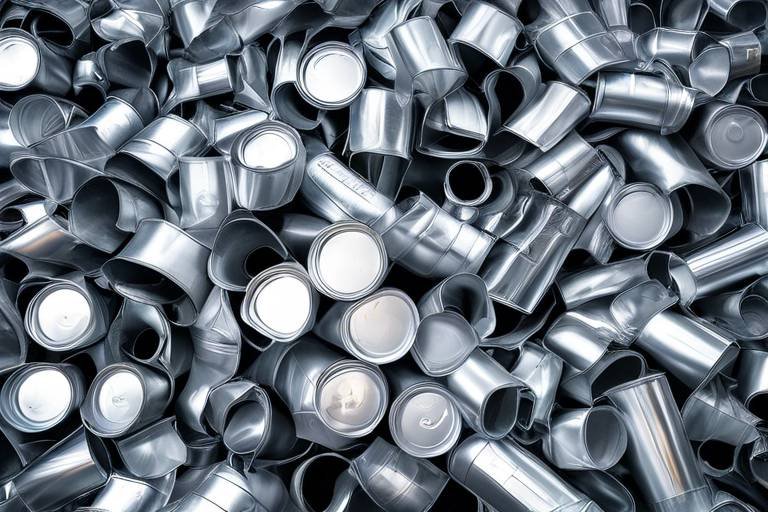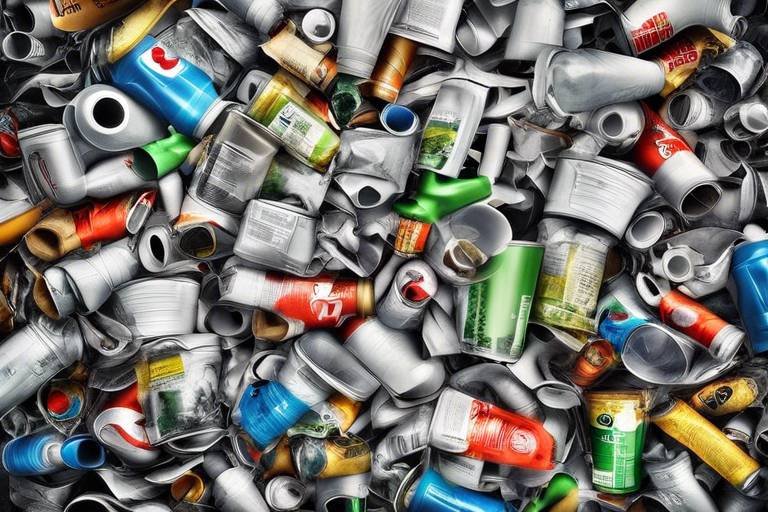The Impact of Your Coffee Habit on the Environment
Coffee is more than just a morning ritual; it's a global phenomenon that affects our planet in ways many of us might not realize. From the moment those little beans are cultivated on a farm to the time they reach your cup, the environmental impact is profound. Did you know that the coffee you enjoy could be contributing to deforestation, water scarcity, and pollution? In this article, we’ll explore the intricate web of coffee cultivation, production, and consumption, shedding light on how your daily brew can either harm or help the environment. So, grab your favorite mug and let’s dive into the world of coffee and its ecological footprint.
Understanding the cultivation process is essential to grasping its environmental impact. Coffee is primarily grown in tropical regions, where lush landscapes are often cleared to make way for coffee plantations. This practice not only leads to deforestation but also disrupts local ecosystems. The use of land for coffee cultivation can result in a significant loss of biodiversity, as native plants and animals are displaced. Furthermore, many coffee farms rely heavily on monoculture practices, where a single crop is planted over large areas. This lack of diversity can make the ecosystem more vulnerable to pests and diseases, leading to a heavier reliance on chemical pesticides.
Water is a critical resource in coffee production, and its consumption is staggering. On average, it takes about 2,000 liters of water to produce just one kilogram of coffee. This high demand places immense pressure on local water resources, often leading to scarcity for nearby communities. In regions where water is already limited, coffee farming can exacerbate the situation, creating conflicts over water usage and threatening the livelihoods of local populations. As coffee drinkers, we must consider the ripple effects of our consumption on these vital ecosystems.
Different irrigation techniques can either mitigate or exacerbate water usage. Traditional methods may waste significant amounts of water, while sustainable irrigation practices can help conserve this precious resource. Techniques such as drip irrigation and rainwater harvesting allow farmers to optimize water use, ensuring that coffee plants receive the moisture they need without draining local supplies. By adopting these methods, we can help protect the environment while still enjoying our favorite beverage.
When comparing rainfed and irrigated coffee systems, the environmental impacts become even clearer. Rainfed coffee relies on natural precipitation, which can be more sustainable but also risky in areas prone to drought. On the other hand, irrigated coffee systems can ensure consistent yields but often lead to over-extraction of water resources. Understanding these differences helps us make informed choices about the coffee we consume and encourages farmers to adopt practices that prioritize sustainability.
The coffee production process can lead to water pollution through agrochemical runoff. Pesticides and fertilizers used in conventional farming can wash into local waterways, harming aquatic life and contaminating drinking water sources. This pollution not only affects the environment but also poses serious health risks to communities relying on these water sources. Addressing these concerns requires a shift towards more sustainable farming practices that minimize chemical use and protect local ecosystems.
Fortunately, sustainable farming practices can significantly reduce the environmental impact of coffee cultivation. Methods such as shade-grown coffee and organic farming promote ecological balance by preserving natural habitats and reducing chemical inputs. Shade-grown coffee, for instance, is cultivated under a canopy of trees, which helps maintain biodiversity and improve soil health. By choosing coffee that is produced using these sustainable methods, we can enjoy our daily cup while supporting practices that protect the planet.
The carbon footprint associated with coffee production and transportation is substantial. From the moment coffee beans are harvested to the time they reach your local café, various stages contribute to greenhouse gas emissions. The energy used in processing, packaging, and transporting coffee can add up quickly, making it essential for consumers to be aware of their choices.
Transportation plays a crucial role in the coffee supply chain. The distance coffee travels from farm to cup can greatly influence its carbon footprint. Shipping methods also matter; for instance, air freight generates significantly more emissions than shipping by sea. By choosing locally sourced coffee whenever possible, we can help reduce the environmental impact associated with transportation.
Choosing local coffee over imported options can reduce environmental impact. Supporting local coffee producers not only boosts the local economy but also minimizes the emissions associated with long-distance transportation. Moreover, local coffee is often fresher and can be grown using more sustainable practices. It’s a win-win situation for both your taste buds and the planet!
Coffee consumption generates significant waste, from coffee grounds to packaging. The environmental consequences of coffee waste can be substantial, particularly when it comes to single-use packaging. As consumers, we must consider how to dispose of coffee-related waste sustainably. Innovative solutions are emerging to tackle these issues, and being mindful of our choices can make a big difference.
Did you know that coffee grounds can be repurposed in various ways? They are rich in nutrients and can serve as a natural fertilizer for your garden. Additionally, coffee grounds can be used in composting, helping to enrich the soil and reduce landfill waste. By finding creative uses for coffee waste, we can contribute to a more sustainable cycle and minimize our ecological footprint.
Packaging plays a vital role in coffee's environmental impact. Traditional coffee packaging often ends up in landfills, contributing to waste and pollution. However, innovative packaging solutions are emerging, such as compostable bags and reusable containers. By supporting brands that prioritize sustainable packaging, we can help reduce the overall waste associated with our coffee consumption.
- How can I choose more sustainable coffee? Look for certifications like Fair Trade, Rainforest Alliance, or organic labels, which indicate that the coffee is produced sustainably.
- What are the best ways to recycle coffee grounds? You can use coffee grounds in your garden, add them to compost, or even use them as a natural deodorizer in your home.
- Does drinking coffee have any environmental benefits? While coffee production has environmental impacts, choosing sustainable options can help mitigate these effects and promote eco-friendly practices.

[The Coffee Cultivation Process]
This article explores how coffee consumption affects the environment, examining everything from cultivation practices to waste management, and offers insights on making more sustainable choices in your coffee habits.
Understanding the cultivation process is essential to grasping its environmental impact. Coffee cultivation begins in the fields, where farmers select the right land and climate for growing coffee beans. Typically, coffee is grown in tropical regions, requiring specific conditions like altitude and temperature. However, this also means that vast areas of forest land are often cleared to make way for coffee plantations, leading to significant deforestation and loss of biodiversity.
In the quest for higher yields, many farmers resort to monoculture practices, where a single crop is planted over large areas. While this may seem efficient, it can severely impact local ecosystems. Monoculture reduces biodiversity, making coffee plants more susceptible to pests and diseases, which in turn leads to increased pesticide use. This not only harms the environment but also affects the health of the workers involved.
Another critical aspect of the cultivation process is water consumption. Coffee plants require a substantial amount of water to thrive. Depending on the region and farming methods, the water usage can be staggering. For instance, it takes approximately 140 liters of water to produce just one cup of coffee. This high demand for water can strain local resources, especially in areas already facing water scarcity.
Farmers are increasingly adopting sustainable practices to mitigate these environmental impacts. Techniques such as shade-grown coffee promote biodiversity by allowing other plants to grow alongside coffee, providing habitat for wildlife and reducing the need for chemical fertilizers. Additionally, organic farming methods avoid synthetic pesticides and fertilizers, making coffee cultivation more environmentally friendly.
In summary, the coffee cultivation process is a complex interplay of agricultural practices, environmental considerations, and economic factors. As consumers, understanding these aspects can empower us to make more informed choices about the coffee we drink. By choosing sustainably grown coffee, we can support practices that protect the environment and promote a healthier planet.
- What is the environmental impact of coffee cultivation? Coffee cultivation can lead to deforestation, loss of biodiversity, and high water consumption, impacting local ecosystems.
- How can I choose more sustainable coffee? Look for certifications like Fair Trade, Rainforest Alliance, or Organic, which indicate more sustainable farming practices.
- What are the benefits of shade-grown coffee? Shade-grown coffee promotes biodiversity, reduces the need for chemical fertilizers, and can improve the overall health of the ecosystem.

[Water Usage in Coffee Production]
When you take that first sip of your morning coffee, have you ever stopped to think about the journey it took to get into your cup? One of the most critical aspects of this journey is water usage. Coffee production is notoriously water-intensive, and understanding this can help us appreciate the environmental impact of our daily brew.
On average, it takes about 140 liters of water to produce just one cup of coffee. This staggering figure includes not only the water needed for irrigation but also that used in processing and transportation. In regions where coffee is grown, such as Brazil and Colombia, the demand for water can lead to significant strain on local resources, affecting both the ecosystem and the communities that rely on these water sources.
Water is not just a resource; it’s the lifeblood of coffee cultivation. The way water is managed in coffee farming can have profound effects on the environment. For instance, traditional coffee farming often relies on monoculture practices, which can lead to increased water consumption and soil degradation. This is where sustainable practices come into play, offering a glimmer of hope for both coffee lovers and the planet.
Different irrigation techniques can either mitigate or exacerbate water usage. For example, many farmers still rely on flood irrigation, which can waste a significant amount of water and lead to runoff. However, more sustainable methods, such as drip irrigation, allow farmers to apply water directly to the roots of the plants, minimizing waste and maximizing efficiency. By adopting these techniques, coffee producers can significantly reduce their water footprint while still maintaining high yields.
When comparing rainfed and irrigated coffee systems, it’s essential to consider their respective environmental impacts. Rainfed coffee relies on natural rainfall, which can be a gamble in regions experiencing climate change. On the other hand, irrigated coffee can provide a more consistent water supply, but it often comes with the cost of over-extraction from local water sources. This creates a delicate balance that farmers must navigate to ensure both sustainability and productivity.
While discussing water usage, we cannot ignore the pollution concerns associated with coffee production. The use of agrochemicals, such as pesticides and fertilizers, can lead to runoff that contaminates local waterways. This not only affects aquatic life but also poses serious health risks for communities that depend on these water sources for drinking and agriculture. Addressing these pollution issues requires a concerted effort from farmers, consumers, and policymakers alike.
In conclusion, understanding the water usage in coffee production is crucial for making informed choices about our coffee habits. By opting for sustainably sourced coffee and supporting farmers who prioritize water conservation, we can enjoy our beloved beverage while also protecting the planet's precious resources.
- How much water does it take to produce coffee? On average, it takes about 140 liters of water to produce one cup of coffee.
- What are sustainable irrigation practices? Sustainable irrigation practices, such as drip irrigation, help conserve water by delivering it directly to the plant roots.
- What is the impact of agrochemicals on water? The runoff from agrochemicals used in coffee production can contaminate local waterways, impacting both the environment and community health.

[Irrigation Techniques]
When it comes to coffee cultivation, the method of irrigation can make a world of difference. Imagine your coffee plant as a thirsty traveler in the desert; it needs just the right amount of water to survive and thrive. Different irrigation techniques can either help conserve water or lead to its excessive use, which can have detrimental effects on both the environment and the coffee yield. Traditional methods, such as flood irrigation, often waste significant amounts of water, while more modern techniques aim to strike a balance between efficiency and sustainability.
One of the most promising approaches is drip irrigation. This method delivers water directly to the roots of the plants, minimizing evaporation and runoff. Picture a meticulous gardener who waters each plant just enough to quench its thirst without drowning it. This not only conserves water but also reduces the likelihood of diseases that can arise from waterlogged soil. Furthermore, drip irrigation allows farmers to apply fertilizers more efficiently, leading to healthier plants and better-quality coffee.
Another technique worth mentioning is sprinkler irrigation, which simulates natural rainfall. While it can be effective, it often requires more water than drip systems. However, advancements in technology have led to the development of low-pressure sprinkler systems that can help reduce water usage significantly. These systems are designed to distribute water evenly across the coffee fields, ensuring that every plant receives its fair share.
But what about the age-old practice of rainfed irrigation? This method relies solely on natural precipitation, making it a sustainable option in regions with adequate rainfall. However, it can be a gamble, as unpredictable weather patterns can lead to droughts or floods, jeopardizing the entire coffee crop. Farmers who adopt rainfed systems often have to be creative, implementing contour farming or terracing to maximize water retention in the soil and minimize erosion.
Each irrigation technique comes with its own set of advantages and challenges. The choice of method can depend on various factors, including local climate, soil type, and the specific coffee variety being cultivated. Ultimately, the goal is to find a balance that promotes sustainability while ensuring a robust yield. As consumers, we can play a role in this by supporting coffee producers who implement these sustainable irrigation practices.
- What is the most efficient irrigation method for coffee? Drip irrigation is often considered the most efficient as it conserves water and minimizes waste.
- How does rainfed irrigation affect coffee quality? Rainfed irrigation can lead to variable quality due to inconsistent water supply; however, when managed well, it can produce excellent coffee.
- Are there any innovative irrigation technologies? Yes, technologies like soil moisture sensors and automated irrigation systems are becoming popular for optimizing water usage in coffee farming.

[Rainfed vs. Irrigated Coffee]
When it comes to coffee cultivation, the debate between rainfed and irrigated coffee systems is a hot topic among farmers, environmentalists, and coffee enthusiasts alike. Understanding the nuances of these two methods can shed light on their environmental impacts and help us make informed choices about our coffee consumption. Rainfed coffee relies entirely on natural rainfall for its water supply, while irrigated coffee uses artificial methods to ensure that plants receive adequate moisture, especially in drier climates.
One of the main advantages of rainfed coffee is its lower water footprint. Since it depends on rainfall, this method can help conserve water resources, particularly in regions where water is scarce. However, the reliance on unpredictable weather patterns can lead to inconsistent yields. During periods of drought, farmers may face significant challenges, resulting in lower production and potential economic hardship.
On the flip side, irrigated coffee systems offer more control over water supply. This can lead to higher and more consistent yields, which is crucial for meeting global coffee demand. However, the downside is that irrigation can contribute to water depletion in local ecosystems. For instance, excessive water extraction for irrigation can lower groundwater levels, affecting not only coffee plants but also surrounding flora and fauna. This delicate balance between water use and conservation is a critical consideration in sustainable coffee farming.
To illustrate the differences, consider the following table that compares the key aspects of rainfed and irrigated coffee:
| Aspect | Rainfed Coffee | Irrigated Coffee |
|---|---|---|
| Water Source | Natural rainfall | Artificial irrigation |
| Water Footprint | Lower | Higher |
| Yield Consistency | Variable | More consistent |
| Impact on Local Ecosystems | Less depletion | Potential depletion |
Ultimately, the choice between rainfed and irrigated coffee systems can have profound implications for both the environment and the livelihoods of farmers. Sustainable practices, such as integrated water management and crop diversification, can help mitigate some of the negative impacts associated with irrigation while still allowing for the benefits of consistent yields. As consumers, we can support these sustainable practices by choosing coffee brands that prioritize environmentally friendly farming methods.
In conclusion, whether you prefer rainfed or irrigated coffee, being aware of the environmental impacts of each system is crucial. By making conscious choices and supporting sustainable farming practices, we can enjoy our beloved coffee while also protecting the planet for future generations.

[Water Pollution Concerns]
The journey of coffee from bean to cup is not just a delightful experience; it also carries a significant environmental burden, particularly concerning water pollution. As coffee farms expand to meet the ever-growing demand, the use of agrochemicals such as fertilizers and pesticides has become commonplace. While these chemicals can boost crop yields, they often find their way into local waterways, leading to serious ecological consequences. Imagine a vibrant stream, once teeming with life, turned murky and lifeless due to runoff from nearby farms. This stark reality poses a challenge not just for the environment, but also for the communities that depend on these water sources.
The implications of water pollution are multifaceted. Contaminated water can lead to a decline in aquatic biodiversity, affecting fish populations and other wildlife. Moreover, the health of local communities can be jeopardized, as they rely on clean water for drinking, cooking, and sanitation. In many regions, coffee is grown in proximity to rivers and lakes, making it all too easy for pollutants to leach into these vital resources. The result? A ripple effect that threatens both the environment and human health.
To better understand the severity of this issue, consider the following factors:
- Agrochemical Runoff: Fertilizers and pesticides used in coffee cultivation can wash into nearby water bodies, leading to nutrient pollution and harmful algal blooms.
- Soil Erosion: Deforestation and poor land management practices can increase soil erosion, causing sediment to clog waterways and disrupt aquatic ecosystems.
- Wastewater Management: The processing of coffee can generate wastewater that, if not properly treated, can introduce harmful substances into water systems.
Addressing these water pollution concerns requires a collective effort from farmers, consumers, and policymakers. Implementing sustainable farming practices, such as integrated pest management and organic farming, can significantly reduce the reliance on harmful chemicals. Furthermore, investing in proper wastewater treatment facilities can help mitigate the impact of coffee processing on local water sources. By making conscious choices about coffee consumption and supporting environmentally responsible producers, we can contribute to a healthier planet.
Q: How does coffee cultivation contribute to water pollution?
A: Coffee cultivation often involves the use of fertilizers and pesticides, which can runoff into local waterways, leading to nutrient pollution and harming aquatic ecosystems.
Q: What are the health risks associated with water pollution from coffee farming?
A: Contaminated water can pose serious health risks to local communities, including gastrointestinal diseases and long-term health effects from exposure to pollutants.
Q: How can consumers help reduce water pollution linked to coffee?
A: Consumers can support sustainable coffee brands that prioritize environmentally friendly practices, thereby reducing the overall impact of coffee production on water quality.

[Sustainable Farming Practices]
When it comes to coffee cultivation, the term sustainable farming practices is more than just a buzzword; it represents a crucial shift towards protecting our planet while still enjoying our favorite brew. By adopting these practices, farmers can not only enhance the quality of their coffee but also contribute to the health of the environment. One of the most effective methods is shade-grown coffee, where coffee plants are grown under the canopy of trees. This approach not only helps preserve biodiversity by providing habitats for various species but also reduces the need for chemical fertilizers and pesticides, as the natural ecosystem works to maintain balance.
Another sustainable practice gaining traction is organic farming. This method avoids synthetic chemicals, opting instead for natural fertilizers and pest control methods. Organic coffee farms often boast healthier soil, which in turn leads to better coffee quality. Moreover, organic farming practices can help sequester carbon in the soil, contributing to climate change mitigation. However, transitioning to organic farming is not without its challenges, as it often requires more labor and time to build up the soil health and manage pests naturally.
Furthermore, implementing agroforestry systems can significantly enhance sustainability in coffee production. By integrating coffee cultivation with other crops and trees, farmers can create a more resilient farming system. This not only diversifies their income but also improves soil health and water retention. The combination of different plants can lead to a more stable ecosystem, reducing the risk of crop failure due to pests or climate fluctuations.
To put the environmental benefits into perspective, consider the following table that highlights the differences between conventional and sustainable coffee farming practices:
| Aspect | Conventional Farming | Sustainable Farming |
|---|---|---|
| Use of Chemicals | High | Low to None |
| Biodiversity | Low | High |
| Soil Health | Degraded | Improved |
| Water Usage | High | Moderate |
| Carbon Sequestration | Minimal | Significant |
Incorporating sustainable farming practices not only benefits the environment but also enhances the quality of coffee. Consumers are becoming increasingly aware of the environmental footprint of their choices, and they often prefer coffee that is ethically sourced and produced. By supporting farmers who adopt sustainable practices, you can help foster a coffee industry that prioritizes the planet's health.
Ultimately, the journey towards sustainability in coffee farming is a collective effort. As consumers, we have the power to influence farming practices by choosing to purchase coffee from brands that prioritize sustainability. Together, we can create a more environmentally friendly coffee culture that respects nature while satisfying our coffee cravings.
- What is shade-grown coffee? Shade-grown coffee is cultivated under the canopy of trees, promoting biodiversity and reducing the need for chemical inputs.
- How does organic farming benefit the environment? Organic farming avoids synthetic chemicals, supporting healthier ecosystems and improving soil quality.
- What is agroforestry? Agroforestry is a sustainable land-use system that integrates trees, crops, and livestock to create a more resilient farming environment.
- Why should I choose sustainable coffee? Choosing sustainable coffee supports environmentally friendly practices, promotes biodiversity, and helps combat climate change.

[Carbon Footprint of Coffee]
The carbon footprint associated with coffee is a significant concern in today's environmentally conscious world. From the moment a coffee bean is planted to the time it reaches your cup, a series of processes contribute to greenhouse gas emissions. These emissions arise from various stages of the coffee supply chain, including cultivation, processing, transportation, and even the brewing of your morning cup. Understanding this footprint is crucial for making informed choices about your coffee consumption.
To put things in perspective, let’s break it down. The average coffee drinker contributes to approximately 2.5 kg of CO2 emissions for every kilogram of coffee consumed. This figure might not seem alarming at first, but when you consider that millions of people worldwide enjoy coffee daily, the cumulative effect is staggering. The journey of coffee beans involves not just the farmers but also processors, exporters, importers, and retailers, each adding to the carbon load.
One of the major contributors to the coffee carbon footprint comes from transportation. Coffee is often grown in tropical regions, such as Brazil, Colombia, and Ethiopia, and then shipped thousands of miles to reach consumers in Europe, North America, and beyond. This global supply chain requires various modes of transport, including trucks, ships, and planes, all of which emit greenhouse gases. Interestingly, the method of transportation can significantly affect the overall emissions. For example, air freight generates much higher emissions compared to shipping by sea, making it essential to consider how your coffee is transported.
Additionally, the cultivation of coffee itself is not without its environmental costs. Traditional farming methods often rely on chemical fertilizers and pesticides, which not only affect the soil but also release nitrous oxide—a potent greenhouse gas—into the atmosphere. Furthermore, deforestation for coffee plantations contributes to the reduction of carbon sinks, exacerbating the problem. The type of farming practices employed can either mitigate or worsen these impacts. For instance, shade-grown coffee promotes biodiversity and reduces the need for chemical inputs, ultimately leading to a lower carbon footprint.
In an effort to combat these emissions, many coffee enthusiasts are turning to local coffee producers. By choosing locally sourced coffee, you can significantly reduce the distance your beans travel, thereby lowering transportation emissions. Supporting local farmers not only helps the environment but also fosters community relationships and promotes sustainable practices.
To summarize, the carbon footprint of coffee is a multifaceted issue that encompasses various stages of production and consumption. By being mindful of your coffee choices—whether it’s considering the source, the transportation methods, or the farming practices—you can play a part in reducing this footprint. The next time you sip your favorite brew, think about its journey and the impact it has on our planet.
- What is the carbon footprint of coffee? The carbon footprint refers to the total greenhouse gas emissions associated with the production, processing, and transportation of coffee, averaging about 2.5 kg of CO2 per kilogram of coffee consumed.
- How does transportation affect coffee's carbon footprint? Transportation contributes significantly to coffee's carbon footprint, with air freight generating much higher emissions compared to sea shipping.
- What sustainable practices can reduce coffee's carbon footprint? Sustainable farming practices such as shade-grown coffee and organic farming can help mitigate environmental impacts, while choosing local coffee reduces transportation emissions.

[Transportation Emissions]
The journey of coffee from farm to cup is a complex one, and it carries a significant environmental burden, particularly in the realm of transportation emissions. Once coffee beans are harvested, they often embark on a long journey that can involve multiple modes of transport—trucks, ships, and sometimes even planes. Each step of this journey contributes to the overall carbon footprint of your morning brew. But have you ever paused to think about how much energy it takes to get that cup of coffee into your hands?
To put things into perspective, let’s consider the distances involved. Coffee is predominantly grown in tropical regions such as South America, Africa, and Asia, while the majority of consumption occurs in North America and Europe. This global trade means that coffee beans can travel thousands of miles before reaching your local café or grocery store. According to a study by the Food and Agriculture Organization (FAO), the transportation of coffee can account for up to 30% of its total carbon emissions. That’s a staggering figure, especially when you think about how many cups are consumed daily!
Additionally, the mode of transportation plays a crucial role in determining the level of emissions. For instance, shipping coffee by sea is generally more sustainable than flying it in. Air freight not only increases costs but also significantly boosts the carbon footprint due to the high fuel consumption of planes. A report from the International Coffee Organization indicates that air-freighted coffee emits approximately 30 times more CO2 than coffee transported by sea. This stark difference highlights the importance of considering how your coffee is transported.
Moreover, local coffee producers often have the advantage of reduced transportation emissions. By choosing to buy coffee from local roasters, you can help shrink the carbon footprint associated with your coffee consumption. Supporting local businesses not only fosters community growth but also minimizes the distance your coffee travels, thus reducing the overall environmental impact. In essence, every time you sip on a cup of locally sourced coffee, you’re making a sustainable choice that benefits both the planet and your community.
As consumers, we have the power to influence the coffee industry by making informed decisions. When shopping for coffee, look for brands that prioritize sustainable transportation methods and local sourcing. This way, you can enjoy your beloved beverage while also being a responsible steward of the environment. Remember, every small choice adds up, and together we can make a significant impact on reducing transportation emissions in the coffee supply chain.
- How can I reduce my coffee's carbon footprint? Opt for local coffee brands, choose sustainably sourced beans, and consider brewing at home to minimize waste.
- What are the main contributors to coffee's carbon emissions? The primary contributors include cultivation practices, transportation, and waste management.
- Is there a difference between organic and conventional coffee in terms of emissions? Yes, organic coffee often has a lower carbon footprint due to more sustainable farming practices.
- How can I recycle coffee grounds effectively? Coffee grounds can be composted, used as fertilizer, or even repurposed for cleaning and deodorizing.

[Local vs. Imported Coffee]
When it comes to our daily cup of joe, the choice between local and imported coffee can have a significant impact on the environment. Imagine sipping your favorite brew while also contributing to a healthier planet. Sounds great, right? But how do these two options stack up against each other? Let's dive into the nitty-gritty of this coffee conundrum.
First off, local coffee typically means that the beans are sourced from nearby farms, which can drastically reduce the carbon footprint associated with transportation. Think about it: if your coffee travels less distance, it means fewer emissions from trucks, ships, and planes. In contrast, imported coffee often comes from far-off lands, requiring extensive shipping that contributes to greenhouse gas emissions. It's like choosing between a quick trip to the local café versus a long-haul flight to get your caffeine fix!
Moreover, supporting local coffee producers can foster economic growth in your community. When you buy local, you're not just getting a fresher product; you're also helping to sustain local farmers and their families. This support can lead to improved farming practices and innovations that benefit the environment. In contrast, imported coffee often supports larger corporations that may not prioritize sustainable practices.
But wait, it’s not just about distance and economics. Local coffee can also offer unique flavors and characteristics that reflect the region's terroir. Each sip can tell a story of the local soil, climate, and farming traditions. Imported coffee, while often delicious, might lack the personal touch and distinctiveness of your local brew. It’s like comparing a home-cooked meal to a frozen dinner—both might fill you up, but one is definitely more satisfying!
Now, let’s consider the environmental practices associated with local versus imported coffee. Local producers may be more inclined to adopt sustainable farming methods, such as shade-grown coffee or organic practices. These methods help preserve biodiversity and reduce chemical usage, promoting a healthier ecosystem. On the flip side, some imported coffee may come from farms that prioritize yield over sustainability, leading to deforestation and habitat destruction.
In summary, choosing local coffee over imported options can significantly reduce your environmental impact. Not only does it cut down on transportation emissions, but it also supports local economies and promotes sustainable farming practices. So next time you're at the store or your favorite café, consider reaching for that locally sourced bag of beans. Your taste buds and the planet will thank you!
- What is the environmental benefit of choosing local coffee? Choosing local coffee reduces transportation emissions and supports sustainable farming practices.
- Does local coffee taste better than imported coffee? Local coffee often reflects the unique flavors of its region, providing a fresher and more distinctive taste.
- How can I find local coffee producers? Check farmers' markets, local coffee shops, or specialty stores that prioritize sourcing from nearby farms.

[Waste Management and Coffee]
When you think about your daily cup of coffee, you might envision the rich aroma, the warmth of the mug in your hands, and that delightful first sip. But have you ever considered the environmental consequences of your coffee habit? From the moment those beans are harvested to the time you toss your used coffee grounds in the trash, coffee consumption generates a significant amount of waste. This waste not only impacts our landfills but also affects local ecosystems and communities. Understanding the environmental implications of coffee waste is crucial for making more informed choices.
One of the primary waste products of coffee consumption is the coffee grounds themselves. Surprisingly, around 60 million tons of coffee grounds are produced globally each year. Instead of simply discarding them, there are numerous ways to repurpose these grounds, turning a potential waste problem into a valuable resource. For instance, coffee grounds can be used as a natural fertilizer due to their rich nitrogen content, which can nourish your garden and promote healthy plant growth. Additionally, they can serve as an excellent composting material, helping to enrich soil and support sustainable gardening practices.
Moreover, coffee grounds can also be utilized in various creative ways. Did you know they can act as a natural deodorizer? Placing dried coffee grounds in your refrigerator or freezer can help absorb unwanted odors. They can also be used as a gentle exfoliant in your skincare routine or even as a cleaning scrub for tough surfaces. The versatility of coffee grounds is a perfect example of how we can reduce waste and promote sustainability in our daily lives.
However, coffee waste is not limited to just the grounds. The packaging in which coffee is sold also contributes significantly to environmental waste. Traditional coffee packaging often consists of non-recyclable materials that end up in landfills, adding to the growing waste crisis. Fortunately, many coffee companies are now shifting towards more sustainable packaging solutions. These innovative options include biodegradable bags, reusable containers, and recyclable materials that minimize environmental impact. By choosing brands that prioritize sustainable packaging, you can help reduce the overall waste generated by your coffee consumption.
In addition to personal choices, the coffee industry as a whole is making strides towards better waste management practices. Many coffee producers are increasingly adopting sustainable practices that focus on reducing waste at every stage of the supply chain. For example, some farms are implementing closed-loop systems where coffee waste is composted and reused, effectively minimizing their overall environmental footprint. Additionally, organizations are working to educate consumers about the importance of sustainable coffee consumption, encouraging them to make choices that support environmentally friendly practices.
Ultimately, managing coffee waste is a shared responsibility between consumers and producers. By being mindful of how we dispose of coffee grounds and supporting brands that prioritize sustainability, we can all contribute to a healthier planet. So, the next time you enjoy your favorite brew, take a moment to consider the impact of your coffee habit on the environment. Together, we can brew a better future.
- What can I do with used coffee grounds? Used coffee grounds can be composted, used as a natural fertilizer, or even repurposed as a deodorizer or exfoliant.
- How does coffee packaging affect the environment? Traditional coffee packaging often consists of non-recyclable materials, contributing to landfill waste. Opting for brands with sustainable packaging can help mitigate this issue.
- Are there sustainable coffee brands? Yes, many coffee brands are focusing on sustainable practices, from farming to packaging. Look for certifications like Fair Trade or Organic to support eco-friendly options.
- Can I recycle coffee packaging? It depends on the materials used. Always check the recycling symbols and guidelines provided by your local waste management services.

[Recycling Coffee Grounds]
Did you know that coffee grounds are one of the most versatile waste products in your kitchen? Instead of tossing them in the trash, you can transform them into valuable resources that benefit both your home and the environment. Coffee grounds are rich in nitrogen, making them an excellent addition to compost piles. When you recycle these grounds, you're not just reducing waste; you're also enriching the soil in your garden. Imagine turning your morning brew into a natural fertilizer that helps your plants thrive!
But that's not all! Coffee grounds can serve multiple purposes. Here are a few creative ways to recycle them:
- Natural Fertilizer: As mentioned, coffee grounds are nutrient-rich. They can be sprinkled directly onto your garden or mixed into compost to enhance soil quality.
- Odor Neutralizer: Place dried coffee grounds in your refrigerator or freezer to absorb unwanted odors. They act like a natural charcoal filter!
- Exfoliant: Use coffee grounds as a natural scrub for your skin. They can help remove dead skin cells and leave your skin feeling rejuvenated.
- Pest Repellent: Sprinkling coffee grounds around your plants can deter pests like snails and slugs, keeping your garden healthy without harmful chemicals.
Recycling coffee grounds not only reduces landfill waste but also promotes a sustainable lifestyle. Instead of contributing to the waste crisis, why not embrace the idea of a zero-waste kitchen? By finding innovative uses for what would otherwise be discarded, you’re making a positive impact on the environment.
Moreover, many communities have started initiatives to collect used coffee grounds from local cafes. These grounds can be composted on a larger scale, demonstrating how collective efforts can amplify individual actions. So, next time you finish your cup of coffee, think twice before throwing those grounds away. Your little actions can lead to significant changes!
Q: Can I use coffee grounds for all types of plants?
A: While coffee grounds are beneficial for many plants, they should be used in moderation. Some plants, like acid-loving ones (e.g., blueberries, azaleas), thrive on coffee grounds, but others may not appreciate the acidity.
Q: How do I store used coffee grounds?
A: Store your used coffee grounds in an airtight container in a cool, dry place. This will help prevent mold and keep them fresh for your garden or other uses.
Q: Are there any downsides to using coffee grounds in my garden?
A: Yes, using too many coffee grounds can lead to a nitrogen overload in your soil. It’s important to balance them with carbon-rich materials like dry leaves or straw to maintain a healthy compost mix.

[Sustainable Packaging Solutions]
In today's world, where environmental concerns are at an all-time high, the packaging of coffee is a crucial aspect that cannot be overlooked. Traditional coffee packaging often involves materials that are not biodegradable and contribute significantly to landfill waste. However, the rise of sustainable packaging solutions is changing the landscape, offering innovative alternatives that not only protect the coffee but also minimize environmental impact.
One of the most promising approaches to sustainable packaging is the use of biodegradable materials. These materials break down naturally over time, reducing the long-term impact on our planet. For instance, some companies are now using compostable bags made from plant-based materials that can decompose within months, unlike conventional plastic that can take hundreds of years. This shift not only helps in reducing waste but also encourages consumers to think more critically about their purchasing choices.
Moreover, recyclable packaging is gaining popularity among eco-conscious brands. By using materials that can be easily recycled, companies are not only lessening their carbon footprint but also promoting a circular economy. For example, aluminum and glass containers are excellent choices, as they can be recycled repeatedly without losing quality. This not only conserves resources but also reduces the energy required to produce new materials.
Another exciting development in sustainable coffee packaging is the use of minimalist designs. By reducing excess packaging and focusing on the essentials, brands can significantly cut down on waste. This approach not only appeals to environmentally-conscious consumers but also often results in cost savings for companies. Imagine opening a beautifully designed coffee bag that uses minimal ink and materials—it's not just about aesthetics; it’s about making a statement that sustainability matters.
Additionally, some coffee brands are exploring refillable packaging options. This innovative approach allows consumers to bring their own containers to stores to refill their coffee, which drastically reduces the need for single-use packaging. It's a win-win situation: customers save money, and the environment benefits from less waste. This model not only fosters a sense of community but also encourages sustainable shopping habits.
As consumers become more aware of the environmental impact of their choices, the demand for sustainable packaging solutions in the coffee industry is likely to grow. Companies that embrace these practices not only contribute to a healthier planet but also position themselves as leaders in the market. The shift towards eco-friendly packaging is not just a trend; it’s a necessary evolution in how we think about coffee consumption.
In conclusion, sustainable packaging solutions are essential in mitigating the environmental impact of coffee consumption. With options ranging from biodegradable materials to refillable containers, the coffee industry is moving towards a more sustainable future. As consumers, we have the power to support these initiatives by choosing brands that prioritize the planet in their packaging choices.
- What are sustainable packaging solutions? Sustainable packaging solutions refer to materials and methods that minimize environmental impact, such as biodegradable, recyclable, or refillable packaging options.
- How can I identify sustainable coffee brands? Look for certifications such as Fair Trade or organic labels, and check if they use eco-friendly packaging materials.
- Are biodegradable coffee bags really effective? Yes, biodegradable coffee bags can decompose significantly faster than traditional plastic bags, reducing landfill waste.
- What can I do with used coffee packaging? Many coffee brands offer recycling programs, or you can repurpose packaging for storage or crafts.
Frequently Asked Questions
- How does coffee cultivation impact the environment?
Coffee cultivation can have a significant environmental impact due to land use, water consumption, and the effects of monoculture practices. These factors can lead to deforestation, loss of biodiversity, and strain on local water resources.
- What are the water usage concerns in coffee production?
Water is a critical resource in coffee production, and its excessive use can affect local ecosystems and water availability for communities. Sustainable irrigation techniques can help mitigate these concerns, promoting better water management in coffee farming.
- What are sustainable farming practices for coffee?
Sustainable farming practices include methods like shade-grown coffee and organic farming. These approaches help maintain ecological balance, reduce chemical inputs, and promote biodiversity, leading to a lower environmental impact.
- What is the carbon footprint of coffee?
The carbon footprint of coffee encompasses emissions from cultivation, processing, and transportation. Each stage contributes to greenhouse gas emissions, with transportation often being a significant factor due to the distances coffee is shipped.
- How can choosing local coffee help the environment?
Selecting local coffee over imported options can significantly reduce environmental impact. Local sourcing minimizes transportation emissions and supports local economies, fostering sustainable practices within the community.
- What happens to coffee waste, and how can it be managed?
Coffee consumption generates waste, including coffee grounds and packaging. Proper waste management practices, such as composting coffee grounds and using sustainable packaging solutions, can help reduce the environmental consequences of coffee waste.
- Can coffee grounds be recycled?
Absolutely! Coffee grounds can be creatively repurposed in various ways, such as composting, using them as a natural fertilizer, or even for beauty products. This not only reduces waste but also adds value to what would otherwise be discarded.
- What are some sustainable packaging solutions for coffee?
Sustainable packaging solutions include biodegradable or recyclable materials that minimize waste. Innovations in packaging design aim to reduce the environmental footprint of coffee while still preserving freshness and quality.



